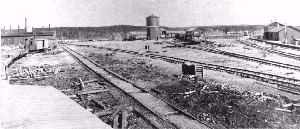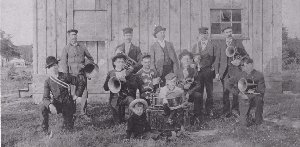In the beginning was the Canadian Pacific Railway.
Building a transcontinental railway was the Canada-making epic of the late 19th century. It was not easy. The terrain between Sudbury and the Lakehead baffled the railroad builders with its ageless granite and bottomless bogs. They started west from North Bay in June, 1881, and didn�t close the line from Callander to Forth William until May 16, 1885. On November 11 of the same year, the whole line from Montreal to Port Moody on the west coast was officially completed when Donald Smith drove home the �last spike� at Craigellachie, just west of Revelstoke in British Columbia. The next year, on June 30, 1886, the first transcontinental train passed through Chapleau on its way to Port Moody.

Chapleau rail yard in 1886.
Chapleau became a community with a future because the C.P.R. needed places at regular intervals along its track where crews could change, locomotives could be refueled and watered, and mechanics could do maintenance work.
At first, the spot in the boreal forest that was later to be named Chapleau was not on the list of bush communities chosen to be a divisional point.
During the construction of the railway, Biscotasing was thought to be a good site for a divisional point and shops and repair houses were indeed built there. With the opening of the Toronto-Sudbury line, Biscotasing was deemed to be too close to Sudbury. Poulin, a railway siding just east of Chapleau, was considered for divisional point status until it was noticed that the supply of water and fuelwood at Poulin could not meet the needs of the locomotives. Chapleau would have to be the divisional point.
And so, in 1885-6, the C.P.R. built repair and engine shops just south of the Kebsquashishing River and moved the maintenance operations from Biscotasing. The economic basis for a lasting community had been established and took the name of Chapleau. Running-crews and mechanics built homes here; merchants moved in to supply their physical needs; and churches were built to meet their social and spiritual needs.
Though isolated amidst the forests and lakes of the Canadian Shield, the self-reliant inhabitants came together to give themselves a few of the outward signs of 19th-century civilization.
One basic need of the community, a cemetery, had been provided for as early as 1885, when the C.P.R. deeded land for the �Chapleau Protestant Burial Grounds� to Thomas Nicholson and James McNiece Austin.
From the beginning, schooling was a priority with the first instruction being given in a tent (1886), but, by May, 1891, the community had its first school house. For the entertainment and edification of adults, a Reading Club was formed in 1887, and that evolved into a Mechanics� Institute (1890).

Chapleau Brass Band in 1889.
The Chapleau Brass Band first met on December 6, 1888, thus establishing the tradition of a Town Band that lasted for over a century. No parade or official event was complete without its presence.
By May, 1893, there was a volunteer fire department in Chapleau. Before the incorporation of the municipality in 1901, policing seems to have been a hit-and-miss thing, with a succession of local men being commissioned by the provincial government to keep the Queen�s peace.
As far as fraternal organizations were concerned, the Brotherhood of Locomotive Firemen and the brotherhood of Locomotive Engineers were up and running in Chapleau by 1886, and the Independent Order of Odd Fellows, Missanabie Lodge No. 266 began its long history in Chapleau on May 16, 1888.
On January 22, 1901, the Victorian Age ended with the death of the old Queen. Edward VII became the King Emperor of history�s largest empire. Sit Wilfrid Laurier was Prime Minister of Canada.
None of these great and distant men were aware of it, but, on February 1, 1901, in a remote part of their domains, the Municipality of the Township of Chapleau came into being. In the sixteen years that had passed since the railway had cut its way across the Canadian Shield, the tiny population had created a lively community complete with churches, schools, a Mechanics� Institute, a volunteer fire department, and a town band. Finally endowed with its own municipal government, Chapleau was ready to take on the 20th century.
(Written by George Evans, largely based on material found in the book, Pioneering in Northern Ontario by Vince Crichton.)